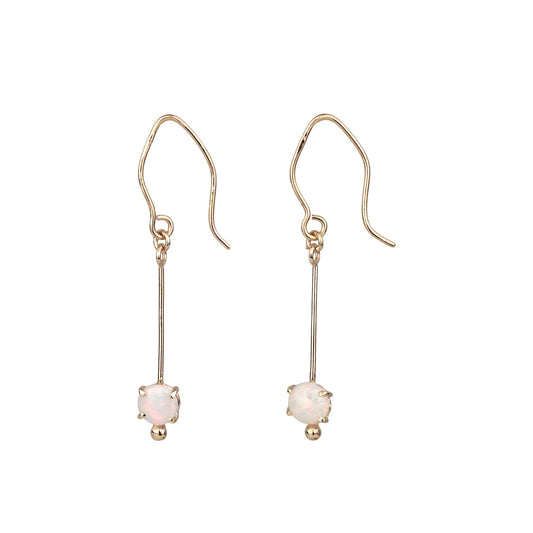Labradorite: The Mesmerizing "Black Moonstone" That Captivates Jewelry Lovers
The first time I held a piece of labradorite, I thought someone had trapped lightning inside a stone. One moment it looked like ordinary gray rock, the next it exploded with electric blues and forest greens that seemed to dance across its surface. That was years before I became a jeweler, but I knew immediately I was looking at something special. This wasn't just another pretty gemstone - this was pure magic you could hold in your hand.
If you've ever seen a gemstone that seems to hold captured northern lights within its depths, you've likely encountered labradorite. This extraordinary stone, with its mysterious flashes of blue, green, gold, and purple, has been captivating jewelry enthusiasts for centuries. As someone who fell in love with labradorite long before I became a professional jeweler, I can tell you there's something absolutely magical about this gem that goes far beyond its stunning appearance.
Let me share everything you need to know about labradorite - from its fascinating discovery story to why I sometimes call it "the black moonstone," and most importantly, how to choose and care for labradorite jewelry that will showcase this remarkable stone's unique beauty.
The Discovery Story: From Labrador to the World
Labradorite's name tells its origin story perfectly - it was first discovered in Labrador, Canada, in the 1770s.
According to local legend, the stone was found by Moravian missionaries (monks) who were amazed by its otherworldly optical effects. The indigenous Inuit people of the region had their own stories about labradorite, believing that the aurora borealis had been trapped within the stone.
While the most famous deposits remain in Labrador, labradorite is now found in several locations worldwide, including Finland, Madagascar, Australia, and parts of the United States. Each location produces stones with slightly different characteristics, but all share that distinctive play of color that makes labradorite instantly recognizable.
Why I Call It "Black Moonstone"
When I first discovered labradorite, I was immediately struck by how it reminded me of moonstone - but moonstone's mysterious, dramatic cousin. Both stones belong to the feldspar mineral family and share that enchanting optical phenomenon called adularescence (the billowy light effect you see moving across the surface). But where moonstone typically shows soft, milky blues and whites, labradorite displays much more dramatic flashes of color against a darker background.
Think of moonstone as gentle candlelight, while labradorite is like lightning in a storm cloud. Both are beautiful, but labradorite has this intensity and drama that immediately caught my attention. It was actually my first favorite gemstone when I started making jewelry - even before that, I was drawn to it as a more unique, striking alternative to traditional moonstone.
The Science Behind the Magic: Understanding Labradorescence
The stunning color flashes in labradorite aren't actually the stone's true color - they're an optical illusion called labradorescence (named specifically for this stone). This phenomenon occurs due to the stone's internal structure, where microscopic layers of different feldspar minerals create interference patterns with light.
How labradorescence works:
- Light enters the stone and hits these internal layers
- Different wavelengths of light are reflected at different angles
- This creates the spectacular flashes of color that seem to move across the surface
- The effect changes dramatically depending on the viewing angle and lighting
This is why labradorite can look completely ordinary from one angle, then suddenly explode with color when you tilt it slightly. It's like having a built-in light show in your jewelry!
The Color Spectrum: What Makes Each Labradorite Unique
One of the most exciting aspects of working with labradorite is that no two stones are exactly alike. The colors you see can include:
Blue labradorite:
- Deep navy to bright electric blue flashes
- Often the most common and dramatic color
- Creates stunning contrast against silver settings
Green labradorite:
- Forest green to bright lime green flashes
- Sometimes appears with golden undertones
- Beautiful in both gold and silver jewelry
Golden labradorite:
- Warm honey to bright yellow-gold flashes
- Often called "golden labradorite" or sometimes "bytownite"
- Spectacular in gold settings
Purple and violet labradorite:
- Rare and highly sought after
- Deep amethyst to bright violet flashes
- Commands premium prices
Multi-color labradorite:
- Shows multiple colors in the same stone
- Can display blues, greens, golds, and purples simultaneously
- Each stone is truly one-of-a-kind
Spectrolite:
- A special variety from Finland
- Shows the full spectrum of colors with exceptional intensity
- Considered the highest grade of labradorite
Understanding Labradorite's Unique Characteristics
The Striations and Surface Features
Labradorite often displays fascinating surface characteristics that add to its appeal:
Natural striations: Many labradorite stones show fine lines or striping across their surface. These aren't flaws - they're natural features that occur during the stone's formation and can actually enhance the play of color.
Schiller effect: Some labradorite displays a metallic, almost mirror-like sheen in addition to the color flashes, creating an even more dramatic appearance.
Color zoning: You might notice that the color flashes appear in specific zones or patterns across the stone's surface, creating natural "maps" of color.
Working with Labradorite: What Jewelry Makers Need to Know
Hardness and Durability Considerations
Labradorite ranks 6-6.5 on the Mohs hardness scale, which makes it moderately soft compared to stones like sapphire (9) or diamond (10). This means a few important things for jewelry wearers:
What this means for everyday wear:
- Perfect for earrings and pendants (lower impact wear)
- Suitable for rings with protective settings
- May show wear over time if worn daily in exposed settings
- Requires more careful handling than harder gemstones
Best jewelry applications:
- Statement pendants that showcase large stones
- Earrings where the stone is protected
- Brooches and pins for special occasions
- Rings with bezel or protective settings
Setting Considerations for Maximum Impact
Because labradorite's beauty depends entirely on how light hits it, the setting is crucial:
Best setting styles:
- Bezel settings: Protect the stone while allowing maximum light exposure
- Open-back settings: Allow light to enter from behind, enhancing the flash
- Minimal prong settings: Keep metal interference to a minimum
- Adjustable or moveable settings: Allow the wearer to find the best angle for color display
Choosing Quality Labradorite: What to Look For
Evaluating Color Flash
Exceptional labradorite:
- Shows intense, vivid color flashes
- Displays color from multiple viewing angles
- Has a good percentage of the stone's surface showing color (70%+ is excellent)
- Shows consistent color without dead spots
Good quality labradorite:
- Shows clear color flashes from at least one angle
- Has reasonable color coverage (40-70% of surface)
- Colors are distinct and not muddy
Lower grade labradorite:
- Shows weak or limited color flashes
- Has large areas with no color activity
- Colors appear dull or muddy
Size and Shape Considerations
Cabochon cuts: Most labradorite is cut as cabochons (smooth, domed shapes) to maximize the labradorescence effect. The quality of the cabochon cut significantly affects the stone's appearance.
Size matters: Larger stones often show more dramatic color displays simply because there's more surface area for the effect to develop across.
Shape variations: Oval and round cabochons are most common, but freeform shapes can be spectacular when they follow the natural color patterns in the stone.
Caring for Your Labradorite Jewelry
Daily Care and Handling
Do:
- Store labradorite jewelry separately to prevent scratching
- Clean gently with warm soapy water and a soft brush
- Remove before activities that might cause impact
- Handle with care during cleaning and wearing
Don't:
- Use ultrasonic cleaners (can cause fractures)
- Expose to harsh chemicals or cleaning products
- Store with harder gemstones that might scratch it
- Wear during heavy physical activities
Long-term Maintenance
Professional cleaning: Have labradorite jewelry professionally cleaned annually, especially if worn regularly.
Repolishing: Over time, the surface might develop small scratches that can be professionally polished out to restore the full color effect, but this is expensive, time consuming and often makes the stone smaller and needs a new setting. You'll want to avoid this.
Setting checks: Have settings checked regularly since the stone's relative softness means secure mounting is especially important.
Labradorite in Modern Jewelry Design
Contemporary Applications
Today's jewelry designers are finding innovative ways to showcase labradorite's unique properties:
Statement pieces: Large labradorite cabochons make stunning centerpieces for bold necklaces and brooches
Minimalist settings: Simple, clean settings that don't compete with the stone's natural drama
Mixed metal designs: Combining gold and silver to complement the stone's multi-colored flashes
Layered looks: Using multiple smaller labradorite stones to create dynamic, movement-filled pieces
Popular Style Trends
Bohemian and nature-inspired jewelry: Labradorite's organic patterns and earth-tone colors fit perfectly with boho aesthetics
Modern minimalism: The stone's inherent drama means it works beautifully in simple, understated settings
Statement earrings: Large labradorite drops and dangles are particularly popular for their movement and light-catching properties
Labradorite Legends and Lore
While I focus on the technical and aesthetic aspects of labradorite, it's worth noting that this stone has a rich history of folklore and legend. The Inuit peoples believed that labradorite fell from the frozen fire of the aurora borealis, which explains its ethereal light display. Finnish folklore suggests that the stone contains the lights of the aurora trapped within its crystalline structure.
These stories, while not scientifically based, speak to the profound impact this stone has had on human imagination throughout history. There's something about labradorite that inspires wonder and storytelling - perhaps it's that element of magic that first drew me to the stone all those years ago.
If you're considering custom labradorite jewelry, look for a jeweler who:
- Understands the stone's optical properties
- Can show you multiple stones to choose from
- Discusses setting options that maximize the color display
- Has experience working with softer gemstones
- Can explain care and maintenance requirements
The Future of Labradorite in Jewelry
As we move forward, I see labradorite continuing to gain popularity, especially among customers who value unique, one-of-a-kind pieces. The stone's natural drama and organic beauty align perfectly with current trends toward sustainable, meaningful jewelry that tells a story.
The increasing rarity of high-quality labradorite, particularly from traditional sources, means that exceptional specimens will likely become even more valuable over time. For collectors and jewelry lovers, now is an excellent time to invest in quality labradorite pieces.
Conclusion: The Magic Continues
Labradorite remains my first favorite gemstone because it never stops surprising me. Every stone is different, every angle reveals something new, and every piece I create with labradorite feels like capturing a moment of natural magic in metal and setting.
Whether you're drawn to its dramatic color play, its rich history, or simply the way it makes you feel when you wear it, labradorite offers something truly special in the world of gemstones. It's not just jewelry - it's wearable wonder, a daily reminder that the natural world still holds mysteries and magic for those who know how to look.
When you find your perfect piece of labradorite jewelry, you're not just acquiring an accessory - you're becoming part of a story that began millions of years ago in the earth's depths and continues every time the light catches your stone just right, revealing that flash of captured lightning that first made me fall in love with this extraordinary gem.
Looking for your own piece of labradorite magic? I hand-forge custom labradorite jewelry that showcases each stone's unique characteristics. Every piece is one-of-a-kind, just like the remarkable stones themselves. Browse my collection or contact me to discuss creating something special that captures your own piece of lightning.
























